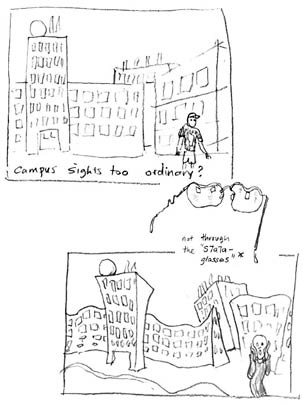The delight of "what if?" lies deep at the heart of MIT life, and Luis Berrios-Negron's vision of capturing that spirit in a design contest and major party will be realized this Friday night at MIT's First Unuseless Beaux Arts Awards Ball, to be held in R&D Common, Stata Center, fourth floor, at 8 p.m.
Berrios-Negron, a graduate student in architecture, organized the "unuseless" contest back in the fall of 2004 with the Graduate Student Office and the Architecture Student Council. He was inspired by MIT's "geeky, yet ultra-cool 'hack' culture" and a series of popular books on "chindogu," the Japanese art of the useless invention, examples of which include little puff-mops that attach to a cat's paws to facilitate dusting. "Chindogu" means, literally, "odd or distorted tool."
The "hack" spirit and the chindogu tradition combine in a contest in which teams of students are guided by faculty advisors to invent unuseless objects. The hope is that this "leisurely yet meaningfully engaging experience would foment transdisciplinarism" among disparate groups at MIT, Berrios-Negron said.
"My biggest, heartfelt critique of MIT is that we have the best resources and talents on the planet, but because of our cloistered lab practices, we are missing out on amplifying collaboration. The Unuseless Competition is a low-browed, light-hearted, small-scale programmatic effort to place art and the creative process in the province of the everyday," Berrios-Negron said.
Five "unuseless" teams of finalists were selected in April and awarded $100 each to manufacture prototypes of their designs. The winner will be determined by audience applause-o-meter at Friday night's ball.
Each unuseless invention has met chindogu tenets including: it must exist, it must not be cruel, its humor must be incidental and it cannot be patented.
Finalists competing for unuseless invention of the year include a "Catsup Crapper," a mobile unit to dispense the condiment Ronald Reagan called a vegetable, designed by Barry Kudrowitz, Bill Fienup, and Marc Graham, all graduate students in mechanical engineering, with advisor Meejin Yoon, assistant professor of design at MIT School of Architecture.
Graham, a poet and veteran of the 2.007 contest, is working on the machine design for "Catsup."
"Chindogu is a bit different from my usual routine, and it is a delight to design something without having to focus on a customer, patent or competition. The project is definitely fun, but not more fun than the daily grind. Fortunately, I love what I do so much that the daily grind results in a daily high," said Graham.
Graduate students Brian Chan, in mechanical engineering, and David Hu, in math, will bring a readymade trifecta to the unuseless awards. They designed a "Will-Powered Chair" that automatically pushes the diner away from dinner, a "Humane Fly-Swatter" with an exit hole, and a pair of "Stata Glasses" that makes any building look like Gehry's unusual form. Chan and Hu's advisor is Chris Csikszentmihalyi, assistant professor of media arts and sciences and Benesse Career Development Professor of Research in Education.
Other unuseless finalists competing on Friday night include "Boomerun," a boomerang that won't ever come back, designed by Liz Burow and Elliot Felix, graduate students in architecture, with advisor Mark Jarzombek, head of history theory and criticism, architecture; "Spike" by Mat Laibowitz, Kelly Norton, graduate students in media arts and sciences, and Mimi Liu, graduate student in electrical engineering and computer science, with advisor Bill Mitchell, academic head, media arts and sciences, and professor of architecture; and "Hairy Bike," by Coryn Kempster, graduate student in architecture, with advisor Margaret Crawford, professor at the Harvard Graduate School of Design.
A version of this article appeared in MIT Tech Talk on May 11, 2005 (download PDF).







